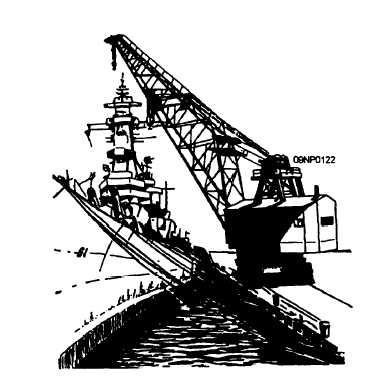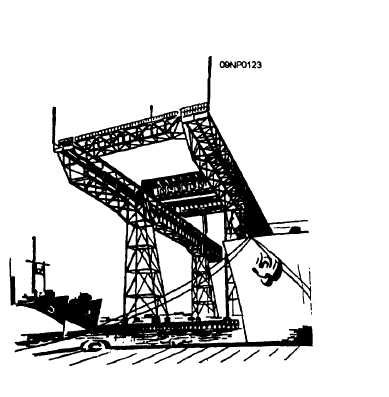| |
Figure 13-23.-Crane, gantry.
to install a crane. The crane bridge is mounted on
trestles having legs which are generally constructed
with wheel trucks for operating on tracks. Such cranes
are referred to as portable gantry cranes.
If the trestles rest directly on the ground or footings,
the term “fixed gantry crane” is applied. This type of
crane is built especially for particular locations. It has
been constructed with a span of 200 or more feet. The
gantry may have a trolley running on the bridge carrying
a hoist. This is the most common form and is what is
meant by gantry crane. However, the gantry may have
a stiff-legged derrick, a rotating pillar, a job crane, or a
hammerhead crane mounted on its bridge as auxiliary
equipment.
Because this type of crane spans the area over which
it operates, it has been particularly useful in
shipbuilding, in storage yards, and at docks for handling
bulk material.
A wharf crane (figure 13-24) is located on and
generally is a part of the wharf or pier structure. It is
particularly adapted to the transfer of Cargo between the
wharf or pier and a vessel.
HOISTS, PULLEYS, AND DOLLIES
Various types of hoists, pulleys, and dollies are
available aboard air stations and ships for moving
equipment and supplies. The SK should be acquainted
Figure 13-24.-Crane, wharf.
with this equipment and its purpose so that as various
situations arise, the SK will be able to select and use the
necessary piece of equipment.
Hoists
Chain hoists or chain falls provide a convenient and
efficient method for hoisting loads by hand. The chief
advantages of chain hoists are that one person can raise
a load of several tons, and the load can remain stationary
without being secured. Manually operated chain hoists
of the type illustrated in figure 13-25 can be carried and
operated by one person. They are particularly useful in
trucks and small storerooms aboard ship and when other
more mechanized equipment is not available.
Some larger storerooms are equipped with
electrically operated hoists which move along overhead
trucks. These hoists have the advantages of speed and
ease of operation.
Block and Tackle
A block and tackle (figure 13-26) is an arrangement
of one or more pulleys with rope or cable for pulling or
hoisting large, heavy objects. The block and tackle
(also called tackle or pulley) is used in the same
situations as the chain hoist for smaller loads.
13-11
|


